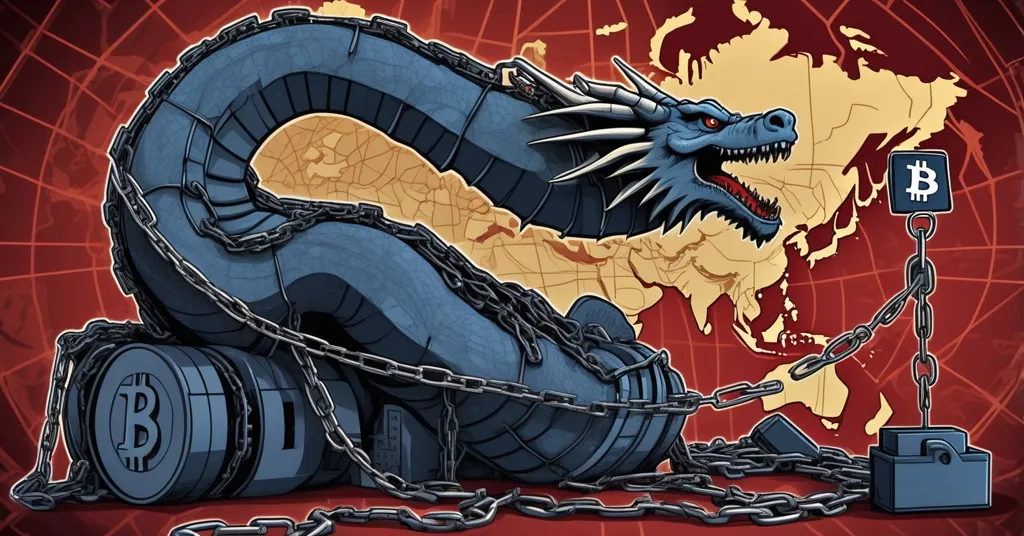EU-China Rare-Earth Dispute: A Serious Threat to Bitcoin Mining and Crypto Hardware

EU-China Rare-Earth Conflict: A Hidden Threat to Bitcoin and Crypto Supply Chains
Geopolitical tensions are brewing between the European Union and China over rare-earth minerals, and the fallout could hit closer to home for the crypto community than you might think. EU Ambassador to China, Jorge Toledo, has openly expressed frustration over stalled relations since a summer summit, despite China’s temporary easing of export controls on these critical materials. While this issue might seem distant from Bitcoin and blockchain, the reality is stark: rare-earths are the backbone of the hardware powering mining rigs and decentralized networks, and Europe’s heavy reliance on China exposes vulnerabilities that could disrupt the very infrastructure of our financial revolution.
- Relations Stagnant: No real progress in EU-China ties since the summer summit, even with minor export control relief.
- Crypto at Risk: Europe’s dependence on Chinese rare-earths threatens Bitcoin mining hardware and blockchain tech production.
- Geopolitical Stakes: Unpredictable trade policies underscore the urgent need for supply chain diversification in high-tech sectors.
Why Rare-Earths Matter to Crypto: A Quick Primer
For those new to the intersection of geopolitics and cryptocurrency, let’s break it down. Rare-earth minerals—a group of 17 elements with unpronounceable names like neodymium and dysprosium—are essential for manufacturing high-performance magnets, batteries, and processors. These components are the lifeblood of tech hardware, including the specialized machines used in Bitcoin mining called ASICs (Application-Specific Integrated Circuits), which are custom-built to solve complex math problems and secure the network. They’re also crucial for GPUs (Graphics Processing Units) that once powered Ethereum mining before its shift to Proof of Stake, and still fuel various altcoin networks. Without rare-earths, the servers and data centers supporting blockchain tech would grind to a halt. China controls 60-70% of the global supply, and when they tighten the tap, the ripple effects hit every corner of tech—including our decentralized dreams.
EU-China Tensions: A Geopolitical Quagmire
At a recent panel in Beijing, Jorge Toledo laid bare the EU’s growing impatience with a situation that’s been widely reported, including insights on the EU’s strained relationship with China over rare-earth trade.
“Things have not improved since the summer summit,”
he stated bluntly, referencing a high-level meeting earlier this year where China agreed to suspend some export controls on rare-earths for a one-year period. He described this move as
“good news and a potential starting point for more cooperation between the EU and China,”
but the optimism was paper-thin. This temporary relief is a drop in the bucket compared to the broader unpredictability of China’s trade whims, which keep European companies—and by extension, crypto hardware manufacturers—on a razor’s edge.
EU heavyweights aren’t pulling punches either. Foreign Policy Chief Kaja Kallas has slammed China’s restrictions, highlighting how they jeopardize entire industries. Her words cut to the core:
“[They] pose significant risks to European companies and endanger the reliability of global supply chains.”
European Commission President Ursula von der Leyen doubled down with a pointed warning that Europe might escalate its response if China doesn’t commit to fair and open trade in these vital materials. The frustration isn’t hard to understand: Europe’s high-tech and green energy sectors, which overlap heavily with blockchain infrastructure, are dangerously exposed when a single nation holds the keys to such a critical resource.
China’s response? Predictably defensive. Foreign Minister Wang Yi justified the export controls as
“a legitimate control over the dual use of materials,”
pointing to their applications in both civilian tech and military hardware. He claimed that
“normal trade channels remain open for European firms,”
and touted a new “fast track” mechanism for export licenses to EU companies. Sounds like a lifeline, doesn’t it? Hardly. Skepticism runs deep, with reports questioning whether this so-called fast track is just a slow crawl through bureaucratic quicksand. Without reliable licensing or a serious push to diversify supply sources, Europe’s industrial base—including the crypto hardware pipeline—remains a geopolitical punching bag.
Historical Baggage: A Lesson in Dependency
This isn’t a new game. China’s dominance in rare-earth production is decades in the making, built on heavy investment and environmental leniency that outpriced competitors. Back in 2010, Beijing slashed exports during a territorial dispute with Japan, sending global markets into chaos and exposing the West’s Achilles’ heel. Prices for rare-earths skyrocketed, tech production stalled, and nations scrambled to find alternatives. Fast forward to today, and Europe is still caught in the same trap. For the crypto world, this isn’t abstract history—it’s a live threat. Imagine a Bitcoin miner in Germany unable to upgrade their rig because a sudden export ban delays shipments of critical components. That’s not just a personal headache; it’s a network-wide vulnerability when multiplied across thousands of nodes.
How Rare-Earth Shortages Threaten Bitcoin Mining and Beyond
Let’s get specific about the hardware at stake. Bitcoin mining relies on ASICs, which use rare-earth elements like neodymium for powerful magnets in cooling systems and other components. These minerals are often irreplaceable due to their unique magnetic properties, making supply disruptions a direct hit to production. Even altcoin networks, like those still using GPU-based mining post-Ethereum’s Merge, face similar risks since GPUs also depend on rare-earth-derived materials for chips and circuits. Beyond mining, the servers and data centers hosting decentralized apps, wallets, and nodes are equally tethered to this supply chain. A single policy shift in Beijing could jack up costs or delay production, throwing a massive wrench into blockchain’s growth engine.
Zooming out, this dependency clashes with the very ethos of decentralization. If Bitcoin is digital gold, rare-earths are the pickaxes—and China’s got a monopoly on the tool shed. Relying on one country for the physical guts of our tech undermines the freedom and resilience we’re fighting for. True decentralization isn’t just about code or consensus mechanisms; it’s about eliminating single points of failure at every level, including the dirty, physical world of raw materials.
Playing Devil’s Advocate: Is Crypto Too Centralized in Hardware?
Let’s flip the script for a moment. Could this crisis be a wake-up call for the crypto industry to rethink its over-reliance on centralized hardware production? Most mining rigs and tech components are churned out in a handful of countries, often with supply chains funneled through China. What if this shortage pushes innovation toward truly decentralized manufacturing—like open-source hardware designs or 3D-printed components? It’s a long shot, sure, but crises often breed creativity. On the flip side, such a shift would take years and massive coordination, leaving us exposed in the meantime. Still, it’s worth asking whether our vision of disruption stops at software or extends to the nuts and bolts of our revolution.
A Bitcoin Maximalist Take: Less Vulnerable, But Not Immune
From a Bitcoin maximalist perspective, there’s an argument that Bitcoin’s simplicity offers a buffer compared to altcoins. Its focus on security and minimalism means it doesn’t demand the same sprawling hardware diversity as, say, Ethereum did during its GPU-heavy mining days. A Bitcoin ASIC is a single-purpose beast, potentially easier to stockpile or source in a pinch. But let’s not kid ourselves—even Bitcoin isn’t immune. A prolonged rare-earth shortage could still choke ASIC production, slow network growth, and spike costs for miners. Maximalism doesn’t shield us from geopolitics; it just narrows the blast radius.
Solutions on the Horizon? Not Holding My Breath
So, what’s the fix? Europe’s chasing what it calls strategic autonomy—basically, relying less on foreign powers for critical stuff like rare-earths. Sounds noble, but it’s a slow grind. Efforts to ramp up mining in places like Australia or Canada are underway, and recycling programs for rare-earths from old tech are gaining traction. Yet, scaling these to meet demand could take a decade, and crypto can’t wait that long. China’s “fast track” licensing is a Band-Aid at best, and betting on Beijing to suddenly play nice with global trade rules is a fool’s errand. Meanwhile, the environmental cost of rare-earth mining—think toxic sludge and wrecked landscapes—clashes with crypto’s growing push for sustainability, especially after Ethereum ditched energy-hogging mining. We’re stuck between a rock and a hard place, pun intended.
One wildcard for crypto could be tech innovation. Could we design more efficient mining algorithms that need less powerful hardware? Or pivot to alternative materials, even if they’re less optimal? These ideas are floating in academic circles and hacker forums, but they’re nowhere near ready for prime time. For now, the community needs to keep pressure on policymakers and industry leaders to prioritize supply chain resilience—because if we don’t, the next export ban could be the one that stalls our momentum.
Broader Context: Supply Chains as the New Battleground
This EU-China standoff isn’t an isolated spat; it’s part of a larger pattern of supply chain disruptions rocking tech. Remember the 2021 chip shortage that crippled everything from car manufacturing to gaming consoles? Crypto hardware wasn’t spared then, with miners scrambling for scarce GPUs. Today’s rare-earth drama is just the latest chapter, a reminder that global trade is a house of cards—and blockchain tech isn’t above the fray. If we’re serious about accelerating toward a decentralized future, we can’t ignore these physical bottlenecks. Freedom and privacy in finance mean nothing if the machines securing our networks are held hostage by a single nation’s policy whims.
Key Questions and Takeaways for the Crypto Community
- Why should crypto enthusiasts care about rare-earth minerals?
These elements are vital for building Bitcoin mining rigs, altcoin hardware, and blockchain servers. Supply disruptions could delay production, raise costs, and slow network growth. - What’s the core risk of Europe’s reliance on China for these materials?
It creates a strategic weak spot—China could weaponize export controls during geopolitical tensions, directly hitting crypto hardware availability and pricing. - Does China’s temporary easing of export controls solve the problem?
Not really—it’s a short-term gesture that doesn’t fix deeper trust issues or ensure long-term stability for European firms or crypto supply chains. - Can Europe break free from this dependency quickly?
Unlikely; building alternative supply sources or recycling programs takes years, leaving blockchain infrastructure vulnerable in the near term. - How does this challenge the spirit of decentralization?
Relying on one country for critical tech components is a glaring single point of failure, contradicting crypto’s ethos of resilience and independence. - Could this crisis spark innovation in crypto hardware?
Possibly—it might push the industry toward open-source designs or alternative materials, though such solutions are far from ready for widespread adoption.
The EU-China rare-earth conflict is a stark reminder that the fight for a decentralized future doesn’t end with elegant code or unbreakable consensus mechanisms. It extends to the gritty reality of global trade, where a single policy shift can kneecap our progress. For Bitcoin maximalists, it’s a call to fortify the network’s resilience against physical disruptions. For altcoin innovators, it’s a warning that no DeFi protocol or NFT marketplace can thrive if the underlying hardware falters. And for everyone in this space, it’s a sobering reality check: the materials powering our revolution are as critical as the ideas driving it. We can’t solve this overnight, but pretending it’s not our problem isn’t an option either. The blockchain future we’re racing toward hinges on getting this right.



